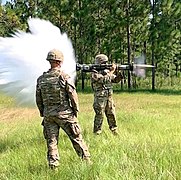
A firearm is any type of gun designed to be readily carried and used by an individual. The term is legally defined further in different countries.
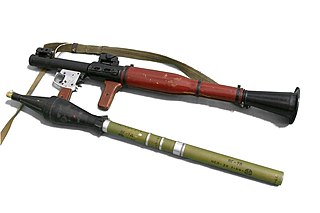
A rocket-propelled grenade (RPG) is a shoulder-fired missile weapon that launches rockets equipped with an explosive warhead. Most RPGs can be carried by an individual soldier, and are frequently used as anti-tank weapons. These warheads are affixed to a rocket motor which propels the RPG towards the target and they are stabilized in flight with fins. Some types of RPG are reloadable with new rocket-propelled grenades, while others are single-use. RPGs are generally loaded from the front.

A recoilless rifle (rifled), recoilless launcher (smoothbore), or simply recoilless gun, sometimes abbreviated to "RR" or "RCL" is a type of lightweight artillery system or man-portable launcher that is designed to eject some form of countermass such as propellant gas from the rear of the weapon at the moment of firing, creating forward thrust that counteracts most of the weapon's recoil. This allows for the elimination of much of the heavy and bulky recoil-counteracting equipment of a conventional cannon as well as a thinner-walled barrel, and thus the launch of a relatively large projectile from a platform that would not be capable of handling the weight or recoil of a conventional gun of the same size. Technically, only devices that use spin-stabilized projectiles fired from a rifled barrel are recoilless rifles, while smoothbore variants are recoilless guns. This distinction is often lost, and both are often called recoilless rifles.

A grenade launcher is a weapon that fires a specially designed, large-caliber projectile, often with an explosive, smoke, or gas warhead. Today, the term generally refers to a class of dedicated firearms firing unitary grenade cartridges. The most common type are man-portable, shoulder-fired weapons issued to individuals, although larger crew-served launchers are issued at higher levels of organization by military forces.

The FGM-148 Javelin, or Advanced Anti-Tank Weapon System-Medium (AAWS-M), is an American-made portable man-portable anti-tank system in service since 1996, and continuously upgraded. It replaced the M47 Dragon anti-tank missile in US service. Its fire-and-forget design uses automatic infrared guidance that allows the user to seek cover immediately after launch, in contrast to wire-guided systems, like the system used by the Dragon, which require a user to guide the weapon throughout the engagement. The Javelin's high-explosive anti-tank (HEAT) warhead can defeat modern tanks by top attack, hitting them from above, where their armor is thinnest, and is also useful against fortifications in a direct attack flight.

A mortar is usually a simple, lightweight, man-portable, muzzle-loaded weapon, consisting of a smooth-bore metal tube fixed to a base plate with a lightweight bipod mount and a sight. They launch explosive shells in high-arcing ballistic trajectories. Mortars are typically used as indirect fire weapons for close fire support with a variety of ammunition.
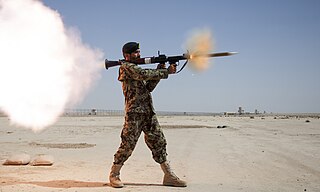
Shoulder-fired missile, shoulder-launched missile or man-portable missile, among other variants, are common slang-terms to describe high-caliber shoulder-mounted weapons systems – that is: weapons firing large heavy projectiles ("missiles"), typically using the backblast principle, which are small enough to be carried by a single person and fired while held on one's shoulder. The word "missile" in this context is used in its original broad sense of a heavy projectile, and encompasses all shells and rockets, guided or unguided. A more formal variant is simply shoulder-fired weapons system and the like.

The Mk 153 Shoulder-Launched Multipurpose Assault Weapon (SMAW) is a smoothbore shoulder-fired rocket launcher. It is a portable assault weapon and has a secondary anti-armor ability. Developed from the B-300, it was introduced to United States Armed Forces in 1984. It has a maximum effective range of 500 metres (550 yd) against a tank-sized target.

The Carl Gustaf 8.4 cm recoilless rifle is a Swedish developed 84 mm (3.3 in) caliber man-portable shoulder-fired recoilless rifle, initially developed by the Royal Swedish Army Materiel Administration during the second half of the 1940s as a close-range anti-tank and support weapon for infantry, which has seen great export success around the globe and is today a popular multi-purpose support weapon in use by many nations. The Carl Gustaf 84 mm recoilless rifle is a lightweight, low-cost weapon that uses a wide range of ammunition, which makes it extremely flexible and suitable for a wide variety of roles.
A rifle grenade is a grenade that uses a rifle-based launcher to permit a longer effective range than would be possible if the grenade were thrown by hand.
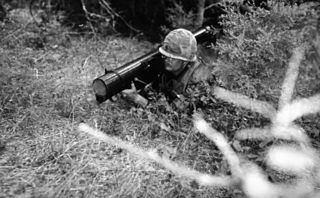
The LAW 80, regularly referred to as LAW 94 in British service, is a man-portable, disposable anti-tank weapon previously used by the British Army and a few other militaries.

The Saab Bofors Dynamics NLAW, also known as the MBT LAW or RB 57, is a fire-and-forget, lightweight shoulder-fired, and disposable (single-use) line of sight (LOS) missile system, designed for infantry use. The missile uses a soft-launch system and is guided by predicted line of sight (PLOS). It can carry out an overfly top attack (OTA) on an armoured vehicle, or a direct attack (DA) on structures and non-armoured vehicles.

The Panzerfaust 3 is a modern semi-disposable recoilless anti-tank weapon, which was developed between 1978 and 1985 and first entered service with the Bundeswehr in 1987. It was first ordered in 1973 to provide West German infantry with an effective weapon against contemporary Soviet armor, thereby replacing West Germany's aging PzF 44 Light Lanze launchers and the heavy Carl Gustaf 84 mm anti-tank recoilless rifle manufactured in Sweden.

The Soviet RPG-22Netto is a one-shot disposable anti-tank rocket launcher first deployed in 1985, based on the RPG-18 rocket launcher, but firing a larger 72.5 mm fin stabilised projectile. The weapon fires an unguided projectile, can be prepared to fire in around 10 seconds, and can penetrate 400 mm of armour, 1.2 metres of brick or 1 metre of reinforced concrete.

Alcotán-100 is a recoilless, one-man portable, single-use anti-tank rocket launcher system used by infantry, manufactured by Instalaza. The firing control unit predicts the future aiming point based on calculation before the rocket fire. It is being used as an infantry-type weapon and fireable from confined spaces. Instalaza claiming it to be, "the highest performance in unguided shoulder launched systems". It is in service with the Spanish Armed Forces and exported to other countries.

The M141 Bunker Defeat Munition (BDM) is a disposable single-shot, shoulder-fired rocket launcher designed to defeat hardened structures. It is a modification of the United States Marine Corps Mk 153 Shoulder-Launched Multipurpose Assault Weapon (SMAW) and is also called the SMAW-D. It was designed to fill the void in the United States Army inventory of a "bunker buster" weapon.
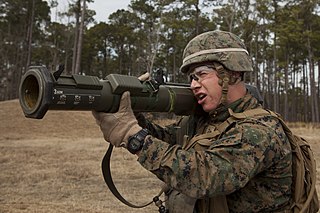
The AT4 is a Swedish 84 mm (3.31 in) unguided, man-portable, disposable, shoulder-fired recoilless anti-tank weapon manufactured by Saab Bofors Dynamics. The AT4 is not a rocket launcher strictly speaking, because the explosive warhead is not propelled by a rocket motor. Rather, it is a smooth-bore recoilless gun. Saab has had considerable sales success with the AT4, making it one of the most common light anti-tank weapons in the world. The M136 AT4 is a variant used by the United States Army.
Soft launching is the method of launching a missile in such a way that the rocket motor ignites outside of the launch tube; the missile is ejected non-explosively. The objective is to minimize the risk of damage to the launcher by maintaining a safe distance. This is in contrast with hard launching, where the missile's rocket engine is ignited while still inside the launch assembly or tube, which generates a backblast area.

Man-portable anti-tank systems are traditionally portable shoulder-launched projectile systems firing heavy shell-type projectiles, typically designed to combat protected targets, such as armoured vehicles, field fortifications and at times even low-flying aircraft.

The Akeron MP, formerly known as MMP, is a French fifth generation, network-enabled, anti-tank guided missile system. Featuring both fire-and-forget and command guidance operating modes, it also integrates third party target designation for indirect firing scenarios through its lock-on after launch capability for non-line-of-sight (NLOS) use.



